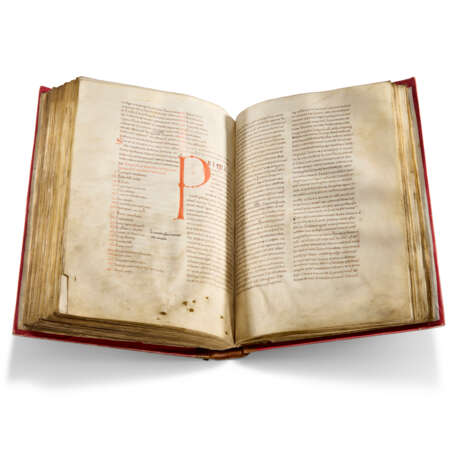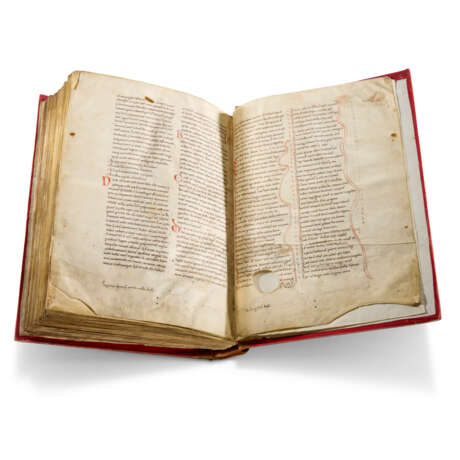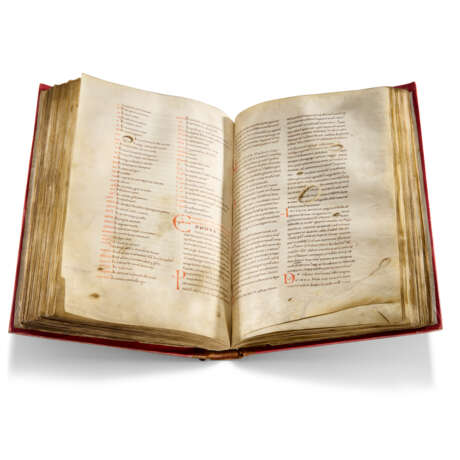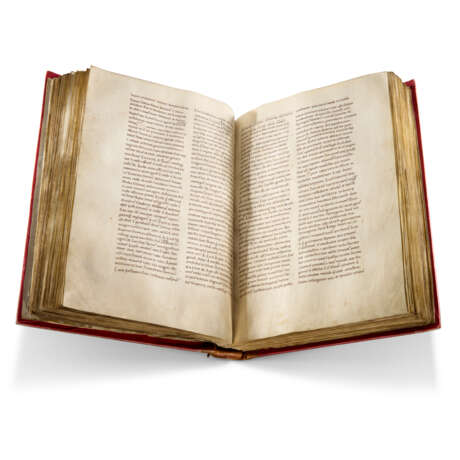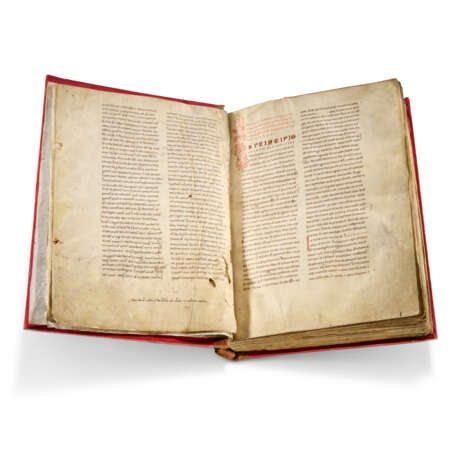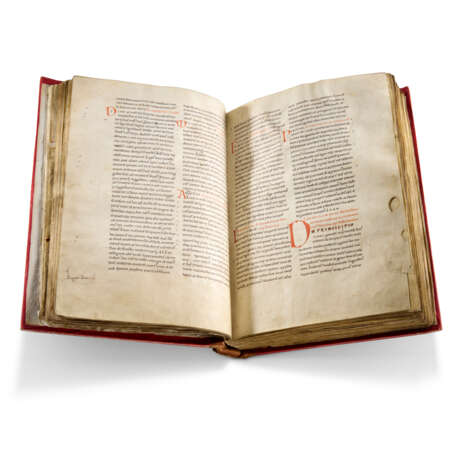ID 1214853
Lot 10 | A 12th-century compilation
Valeur estimée
£ 120 000 – 180 000
Bede (c.672-735), Wigbod (fl. 786), and Isidore of Seville (c.560–636), Commentaries on Genesis, and on the other first books of the Bible, etc., in Latin with some words in Greek majuscules, decorated manuscript on vellum [Germany, 12th century]
A rare compilation of texts, probably derived from a 9th-century exemplar, concluding with a catalogue of books known or owned by Isidore of Seville.
350 × 250mm. i + 126 + i leaves, formed of a complete manuscript (ff.3–126) preceded by three leaves from another book (ff.i, 1–2), collation: 13 (of 4, iv missing), 2–168, 174, most gatherings except the first with a quire signature in roman numerals, i–[xvi], ruled in leadpoint for 2 columns of 28 lines written in late caroline minuscule: 250 × 170mm, some rubrics and incipits in rustic capitals, many small and 10 large large initials in red, some, including the first, with foliate ornament (the outer margin of f.67 excised, many natural flaws in the vellum, not caused by damage and not affecting legibility). 19th-century French binding, sewn on 9 bands attached to half brown leather and red paper over pasteboards, the spine with two green leather title-pieces lettered in gilt capitals ‘Istoria / sacre’ (cf. f.1) and ‘Manuscrit / velin / 12e sciecle [sic]’; the fore-edge of the first two leaves with holes and rust-stains from the metal fittings of the clasps of a previous binding (somewhat worn, but sound).
Provenance:
(1) Annotated and corrected in the 12th century by several hands.
(2) ? Amans-Alexis Monteil (1769–1850), historian, whose manuscripts were sold in 1833, 1850 and 1851: in the catalogue of the Phillipps library (see below) this manuscript is listed under the heading ‘Ex Bibliotheca Monteil, & Royez, Parisiis’.
(3) Unidentified 19th-century French bookseller or auctioneer: with a clipping from their catalogue, mentioning the previous binding, ‘Explanatio operis sex dierum ex dictis sti. Augustini et sti. Ambrosii. […] douzieme siecle, in-fol, rel. en bois.’ (f.i verso).
(4) Royez, bookseller, of Paris: with his(?) price ‘150ff’ (front pastedown); acquired by:
(5) Sir Thomas Phillipps (1792–1872): his MS 1347, with his ink-stamped crest and spine-label printed ‘1347’; by descent to his grandson, Thomas Fitzroy Fenwick, who sold a large residue of the collection to:
(6) Lionel and Philip Robinson, booksellers of London, who sold many and then, in turn, sold the residue to:
(7) H.P. Kraus, New York: their Catalogue 153: Bibliotheca Phillippica: Manuscripts on Vellum and Paper from the 9th to the 18th Centuries, from the Celebrated Collection Formed by Sir Thomas Phillipps, the Final Selection (1979), no 17, priced $40,000, bought by:
(8) The Schøyen Collection, MS 229.
Content:
1. Isidore, Commentary on Genesis, two leaves only, beginning with a space for an initial, ‘[H]istoria sacre legis […]’, , f.1, ending at ‘ […] operatus est in Virgine unde natus est Christus’.
2. Ps-Bede, De sex dierum creatione, f.3, with rubric ‘In nomine dei summi incipit explanatio sex dierum in quibus deus celum & terram ceteraque condidit sumpta ex dictis sancti Augustini & sancti Ambrosii’. The authorship of this text is disputed; Gorman suggested it was by Wigbod, but this has been refuted by G.E. Kreuz: ‘“Inquiri mihi necesse est […]” Überlegungen zu drei vermuteten kleineren Genesiskommentaren Wigbods’, Wiener Studien, 122 (2009), pp.223–47.
3. Bede, Hexameron (Commentary on the six days of the Creation), f.16, the first recension (ed. Corpus Christianorum, Series Latina, 118A; this manuscript apparently unknown to the editors), with rubric ‘Exameron Bede dilectissimo ac reverentissimo Acca humilimus famulorum Christi Beda salutem’.
4. Wigbod, Commentary on the Octateuch: Genesis, f.26, Exodus, f.88, Leviticus, f.98, Numbers, f.102v, Deuteronomy, f.108, Josua, f.112, Judges, f.114, and Ruth, f.117; the first rubric is ‘Incipit liber questionum super Genesis ex dictis sanctorum patrum Augustini Gregorii Hieronimi Ambrosii Hilarii Isidori Eucherii & Iunilii’. The text was printed by Herwagen in 1563 as a work of Bede, and this was reprinted by Migne, PL, 93, cols.233–430.
5. Isidore, Commentary on the books of Kings, f.117v.
6. Isidore, Versus qui in Bibliotheca sancti Isidori legebantur, f.126r–v.
Wigbod is probably to be identified as the Abbot of St Maximin, Trier, whom Charlemagne sent on diplomatic missions (e.g. to England in 786); he seems to have known Alcuin, and may himself have been an Anglo-Saxon. We know from the dedicatory verses prefaced to a copy of his work (formerly at St Maximin, Trier, but lost since the 18th century), that it was written for Charlemagne. Though he had access to works by Augustine, Gregory, Jerome, Ambrose, Hilary, and others, and drew on them for his commentary on Genesis 1–3 (from the Creation until Adam and Eve are expelled from the Garden of Eden), for the other chapters and books he relied almost entirely on Isidore of Seville. The text is known to survive in eleven manuscripts; the present copy probably descends from Oxford, Bodleian Library, MS Laud Misc. 159, which has items 2–4 in the same sequence; it was written at Lorsch Abbey in the 2nd quarter of the 9th century, and was probably there until at least the 13th century. The relationship is not likely to be direct however because, for example, the 9th-century manuscript lacks the rubric found on f.3 of the present manuscript.
Another interesting text is the Versus of Isidore, a 'catalogue' of the library of Isidore of Seville in the form of a poem, listing the books that he owned, read or of which he was aware, starting with the Bible, and continuing with the Greek and Latin Church Fathers, pagan and Christian authors, juridical writings and works of the artes liberales. This catalogue often appeared in medieval copies of Isidore's works: some 38 manuscripts survive today.
Literature
Gorman, M., ‘The Encyclopedic Commentary on Genesis Prepared for Charlemagne by Wigbod’, Recherches augustiniennes, 17 (1982), pp.173–201, citing and describing the present manuscript at pp. 195 n.87, 196, 197 n.101, and 199; reprinted in Biblical Commentaries from the Early Middle Ages (2002), pp.1–29.
Gorman, M., ‘Wigbod and the Lectiones on the Hexateuch Attributed to Bede in Paris lat. 2342’, Revue Bénédictine 105 (1995), pp. 310–47.
Gorman, M., ‘The epitome of Wigbod's Commentaries on Genesis and the Gospels’, Revue bénédictine, 118, (2008), pp. 5-45.
| Lieu d'origine: | Europe de l'Ouest, Allemagne, Europe |
|---|---|
| Catégorie maison de vente aux enchères: | Manuscrits médiévaux et de la Renaissance, Livres et manuscrits |
| Lieu d'origine: | Europe de l'Ouest, Allemagne, Europe |
|---|---|
| Catégorie maison de vente aux enchères: | Manuscrits médiévaux et de la Renaissance, Livres et manuscrits |
| Adresse de l'enchère |
CHRISTIE'S 8 King Street, St. James's SW1Y 6QT London Royaume-Uni | |
|---|---|---|
| Aperçu |
| |
| Téléphone | +44 (0)20 7839 9060 | |
| Commission | see on Website | |
| Conditions d'utilisation | Conditions d'utilisation |
